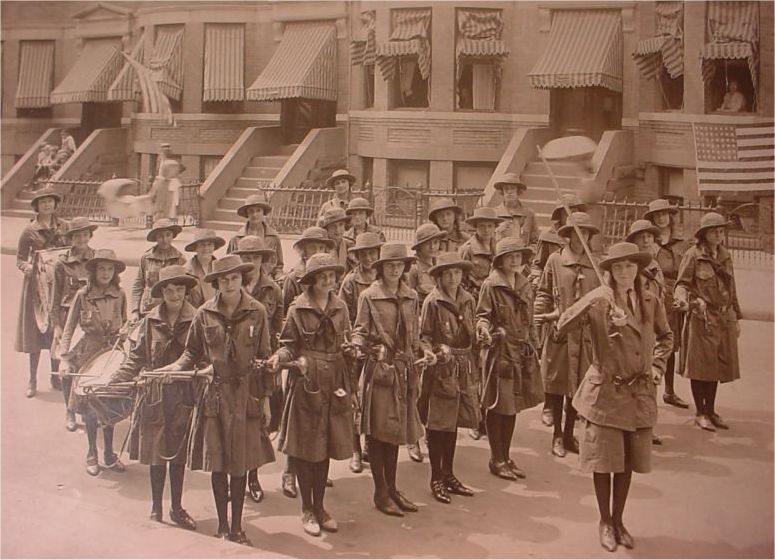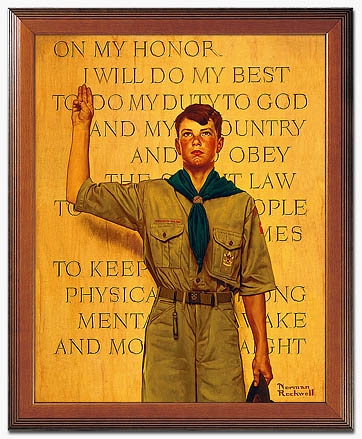Why Americans Educate Their Children Better Than We Do
Are China's educational methods inferior to those practiced in the United States? According to this amazingly critical op-ed article that appeared in China's State-controlled Oriental Morning Post, China's educational system, which relies on by-rote memorization and the coddling of children, needs a complete overhaul, and the authorities should seriously consider a Chinese version of the Girl Scouts.
By Mr. Yong Xue, Under Special Arrangement with the Oriental Morning Post
Translated By Mark Klingman
March 24, 2006
China - Oriental Morning Post - Original Article (Chinese) 
 The Girl Scouts: America's Secret Weapon?
The Girl Scouts: America's Secret Weapon?
[ Girl Scouts of America]
Girl Scouts of America]
-------------------------------------------------
I read an article recently about a program broadcast on China Central
Television last year, an episode of "Dialogue" that involved Chinese
and American high school students just about to enter the university. In one
segment that explored personal values, the host had the students select which
was most important to them: wisdom, power, truth, wealth, or beauty. What
astonished me was that the American students all had nearly identical
selections - they all chose either truth or wisdom. But among the Chinese students
there was not even one who chose truth or wisdom. One chose beauty, and the
rest either wealth or power.
Following that, each group was asked to create an imaginary aid
program for poor children in Africa. The Chinese students were mainly
interested in showing off their knowledge of the Silk Road [ ], of the
voyages of the mariner Zheng He to Arabia [
], of the
voyages of the mariner Zheng He to Arabia [ ], of ancient songs, and then
how one of them could play the gu zheng [the Chinese Zither],
one the piano, one the flute, and one sang in a choir, etc. The aid program to
Africa was mentioned only superficially: they said that they would solicit
donations for a trip to Africa, perhaps to construct a "Hope Primary School"
[that is, similar to the schools built by Project Hope, a Chinese rural
outreach charity]. Some people in the
audience asked: "You want to collect
money - you want me to give a little of the bread off of my table - so how
exactly do you plan to spend it?" Our students looked at each other in
blank dismay, and could give no reply.
], of ancient songs, and then
how one of them could play the gu zheng [the Chinese Zither],
one the piano, one the flute, and one sang in a choir, etc. The aid program to
Africa was mentioned only superficially: they said that they would solicit
donations for a trip to Africa, perhaps to construct a "Hope Primary School"
[that is, similar to the schools built by Project Hope, a Chinese rural
outreach charity]. Some people in the
audience asked: "You want to collect
money - you want me to give a little of the bread off of my table - so how
exactly do you plan to spend it?" Our students looked at each other in
blank dismay, and could give no reply.
The plan of the American high school students, in contrast, included
some sociological details that might never have occurred to many of us. They began with actual problems such as
education, employment, AIDS, contraception, and availability of food and clean
water. For each item, they discussed what was most practical to do, what preparations
were necessary, and they even prepared a budget that was detailed down to the
last penny. The entire plan could have been implemented on the spot.
I pasted this article on my own Web page at Sina Net, and almost
immediately it got more than 100,000 hits and 500 messages. This contrast in
education left a lot of hurt feelings among our friends on the Web. As to why Chinese
education doesn't produce such results, the article's original author Ms.
Shuzhen Xiao has already made quite a thorough analysis. It's not necessary for
me to add too much on this count, but speaking as someone who has lived for
over 10 years in the United States, I feel I have the responsibility to share my
own observations. How can it be that American and Chinese children are so different?
 The Girls Scouts, and Boy Scouts,
are Time-Honored
The Girls Scouts, and Boy Scouts,
are Time-Honored
American Institutions. The Girl Scouts Were Founded
in 1912, and the Boy Scouts in 1908. (above and below).


 --------------------------------------------------------------------------------
--------------------------------------------------------------------------------
I might as well begin with my six-and-a-half-year-old daughter's
experience in kindergarten and elementary school. When she was five, she began
to participate in the Girl Scouts. This organization is very popular among American
girls, but the structure is very loose - several parents are involved, and each
in turn volunteers to take care of the group. When my daughter turned six, they
announced her new appointment: she was going to sell cookies, with the goal of
fostering her social and monetary skills. The Girl Scouts Web site [ ] flatly states that many successful American entrepreneurs got their start
selling Samoas and Tagalongs [cookies]. Each box of cookies costs four dollars,
which is at least 30% higher than the store price. Such a way to teach a child to
make money! Isn't it a little too much? But as soon as we tried to sell our first box,
I saw that no one was put off by the price.
] flatly states that many successful American entrepreneurs got their start
selling Samoas and Tagalongs [cookies]. Each box of cookies costs four dollars,
which is at least 30% higher than the store price. Such a way to teach a child to
make money! Isn't it a little too much? But as soon as we tried to sell our first box,
I saw that no one was put off by the price.
At first, even if it was someone she knew, my daughter was shy and
couldn't even open her mouth. But all the adults became especially kind and
warm when they saw her standing there timidly in her little uniform. They would
come right over and ask: "What are you doing there? Selling cookies? How many boxes can I buy?"
Under this kind of guidance and
encouragement from her "customers," her little business was soon
doing quite well. Many customers told us that they grew up selling Girl Scout
cookies. Gradually, my daughter dared to open her mouth to sell on her own
initiative. I was shocked.
There are four kinds of cookies- doughy ones, chocolaty ones, and
so on. Each time a child sells one kind,
she wants to explain all the other varieties, and why they should buy a box of
those too. Then as she calculates the bill at $4 a box, she's learning mathematics.
Specifically, her method is: find a customer, take an order, write down the
quantity of the sale, then "stock the goods," "deliver the goods,"
and receive payment. She must walk through all the steps of a small
business. After several weeks, my daughter
had unexpectedly sold 32 packages. Total amount: $128.
When all the cookies had been sold, everyone came together to see
how much they had made, and to let the children discuss how the money should be
spent. The verdict was that the money should be divided three ways. The first third went to the organizers,
because they did most of the work, and even had to spend some of their own
money. The girls thought this was unfair, and they wanted to pay them instead
of letting them work as volunteers. In other words, the children "employed"
the adults with the money they made from their own labor. The second part of the
money was to go to the homeless. This was my daughter's special request. She was born in New Haven, a very poor city;
we had no car, and the trip back and forth to buy groceries took more than an
hour. From her seat in the baby carriage
she saw many homeless people every day, and so before she was even three years
old she had a dream: when she grew up she would open a restaurant for poor
people. They wouldn't have to spend anything; it would operate on donations
from the rich. The third part of the money was to hold a pizza party.
If you know that the U.S. trains its children this way, it's very
easy to understand the difference between Chinese and American high school
students. American children are truly very practical, and begin to make and
calculate money from childhood. They all realize the value of money early on, and
don't neglect even a penny. So now I teach my daughter this way: When you want something,
you must start doing something to get it - for instance, study, practice the qin [musical instrument], or help me with my housework. Nothing comes
by itself, but must be earned. "After you make your money," as we
used to say when I was a kid, "you can think about how two-thirds of the
world is poor" and doesn't have the opportunities that you do.
This kind of education changed her personal values. Once she and
her mother were discussing one of her children's books, in which a grandmother
said to her granddaughter that if she grew up to marry a prince, her life's
work would be accomplished. Her mother asked what she thought about that. She immediately
answered that this was not good, because such a person could only be a
spectator in life, and would not have any way of participating and learning. It
seems that children's values are dependent on what adults teach them.

 The World Association of Girl Guides and Girl Scouts Operates
The World Association of Girl Guides and Girl Scouts Operates
in 144 Countries. Left, are Some Scouts in Hong Kong, and Right, India.
[ World Association of Girl Guides and Girl Scouts]
World Association of Girl Guides and Girl Scouts]
-------------------------------------------------------------------------------------
What do adults teach children here [in China]? We might organize an
activity to aid African disaster victims, but everything is done by the school
- for the children, much like a sports meet or other function. By the time they
reach middle school, except for a few ideological tenets that they know by
heart, they act like soldiers receiving orders from on high. On holidays, the
children in our family get to pig out, set off firecrackers, and open their
presents and red envelopes - a picture very different from the spontaneous
organization of the Girl Scouts, who naturally instill in their members the
desire to help others.
I must remind the reader that some outstanding high school students
in the U.S. frequently spend their own money to go to Africa or another needy
area to volunteer, and this experience sometimes becomes their key to getting
accepted into a first-rate university. Americans are not people of great
truths, but live life bit by bit, all the while soaking up this moral
sentiment: "Truth and wisdom are our values; wealth and power, nothing but
a way of realizing them." The meaning of life does not lie in holding
wealth and power, but in fulfilling one's own social responsibility to change
this world for the better.